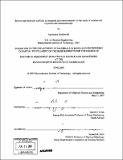| dc.contributor.advisor | Darrell J. Irvine. | en_US |
| dc.contributor.author | Stachowiak, Agnieszka (Agnieszka N.) | en_US |
| dc.contributor.other | Massachusetts Institute of Technology. Dept. of Materials Science and Engineering. | en_US |
| dc.date.accessioned | 2007-11-16T14:20:32Z | |
| dc.date.available | 2007-11-16T14:20:32Z | |
| dc.date.copyright | 2007 | en_US |
| dc.date.issued | 2007 | en_US |
| dc.identifier.uri | http://hdl.handle.net/1721.1/39542 | |
| dc.description | Thesis (Ph. D.)--Massachusetts Institute of Technology, Dept. of Materials Science and Engineering, 2007. | en_US |
| dc.description | Includes bibliographical references (p. 95-108). | en_US |
| dc.description.abstract | Immunotherapies harness the inherent potential of the body to destroy foreign or infected cells, by stimulating new or enhancing existing immune responses. One way to boost insufficient native immunity might be to engineer lymphoid tissue at disease sites (e.g., tumors). Such neotissues could be formed by attracting or transferring immune cells into a defined microenvironment supportive of their activation. In addition to having therapeutic potential, such artificial lymphoid scaffolds could be used as in vitro models to investigate how immune cells respond to changing properties of their environment (e.g., architecture or biochemistry). We developed and tested macroporous poly(ethylene glycol) (PEG) hydrogel scaffolds as a platform for lymphoid tissue models and immunotherapy. By applying the method of colloidal crystal templating to materials and length scales appropriate for soft tissues, PEG hydrogels with arrays of ordered, interconnected pores were prepared. These combined the attractive properties of hydrogels, including biochemical versatility and tissue-mimetic mechanical properties, with the benefits of a macroporous structure, including improved nutrient transport and a defined space for cell interactions. | en_US |
| dc.description.abstract | (cont.) Moreover, the ordered pore arrangement provided high interconnectivity at unprecedented (low) porosities. We primarily tested the migratory responses of T cells to these novel hydrogel scaffolds, due to the importance of rapid T cell motility in promoting efficient immune responses. Varying the choice of adhesion ligand coating the scaffolds prompted significant T cell trafficking only for the case of intercellular-adhesion-molecule I (ICAM-1), and ultimately, a composite scaffold structure was required to attain in vivo-like cell migration. In this modified structure, the porous PEG hydrogel provided mechanical stability and the ability to deliver proteins of interest, while an infused collagen matrix supported intra-scaffold migration of loaded T cells and dendritic cells. We tested the effect of scaffold architecture in the composites, and found that increasing the PEG pore size enhanced T cell motility. We also demonstrated the delivery of the chemokine CCL21 - a cytokine likely to be useful for immunotherapy - to cells within composite scaffolds. This hybrid scaffold approach combines the strengths of the synthetic and biopolymer hydrogels used in a complementary fashion, and may be generally useful for tissue engineering. | en_US |
| dc.description.statementofresponsibility | by Agnieszka Stachowiak. | en_US |
| dc.format.extent | 147 p. | en_US |
| dc.language.iso | eng | en_US |
| dc.publisher | Massachusetts Institute of Technology | en_US |
| dc.rights | M.I.T. theses are protected by copyright. They may be viewed from this source for any purpose, but reproduction or distribution in any format is prohibited without written permission. See provided URL for inquiries about permission. | en_US |
| dc.rights.uri | http://dspace.mit.edu/handle/1721.1/7582 | |
| dc.subject | Materials Science and Engineering. | en_US |
| dc.title | Inverse opal hydrogel scaffolds as lymphoid microenvironments for the study of immune cell migration and immunotherapy | en_US |
| dc.type | Thesis | en_US |
| dc.description.degree | Ph.D. | en_US |
| dc.contributor.department | Massachusetts Institute of Technology. Department of Materials Science and Engineering | |
| dc.identifier.oclc | 174042815 | en_US |
